SOLiD 850C700PS RDU MODULE(850C/700PS) User Manual 2 2
SOLiD, Inc. RDU MODULE(850C/700PS) Users Manual 2 2
SOLiD >
Contents
- 1. Users Manual 1
- 2. Users Manual 2 1
- 3. Users Manual 2 2
- 4. Users Manual 3
Users Manual 2 2
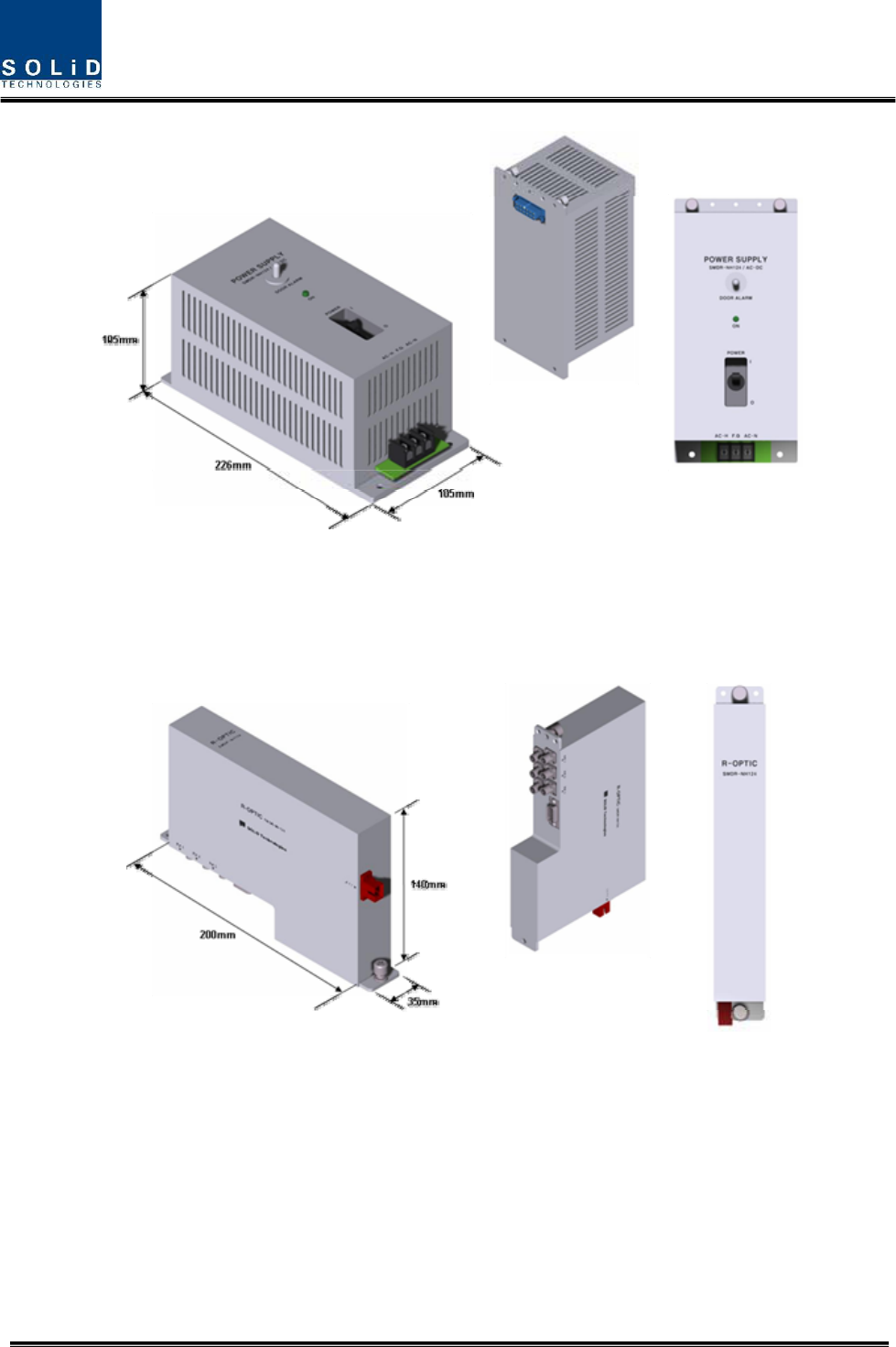
Confidential & Proprietary 46/87
3) Remote Optic(R OPTIC)
Remote Optic converts optical signals into RF signals and performs vice versa. With an FSK
modem in it, the unit communicates with upper devices.
It also has internal ATT for optical compensation to compensate for optical cable loss, if any.
Figure 4.28 – R OPTIC Outer Look
4) Remote Central Processor Unit (RCPU)
RCPU can monitor and control each module of ROU. This unit receives and analyzes upper
communication data from Remote Optic and reports the unit's own value to upper devices. At
the front of the module, it has LED indicator to show system status, letting you check any
abnormalities at a time. At the same front, it also has communication LED Indicators to show
communication status with upper devices. Through RS-232C Serial Port, the unit enables you to
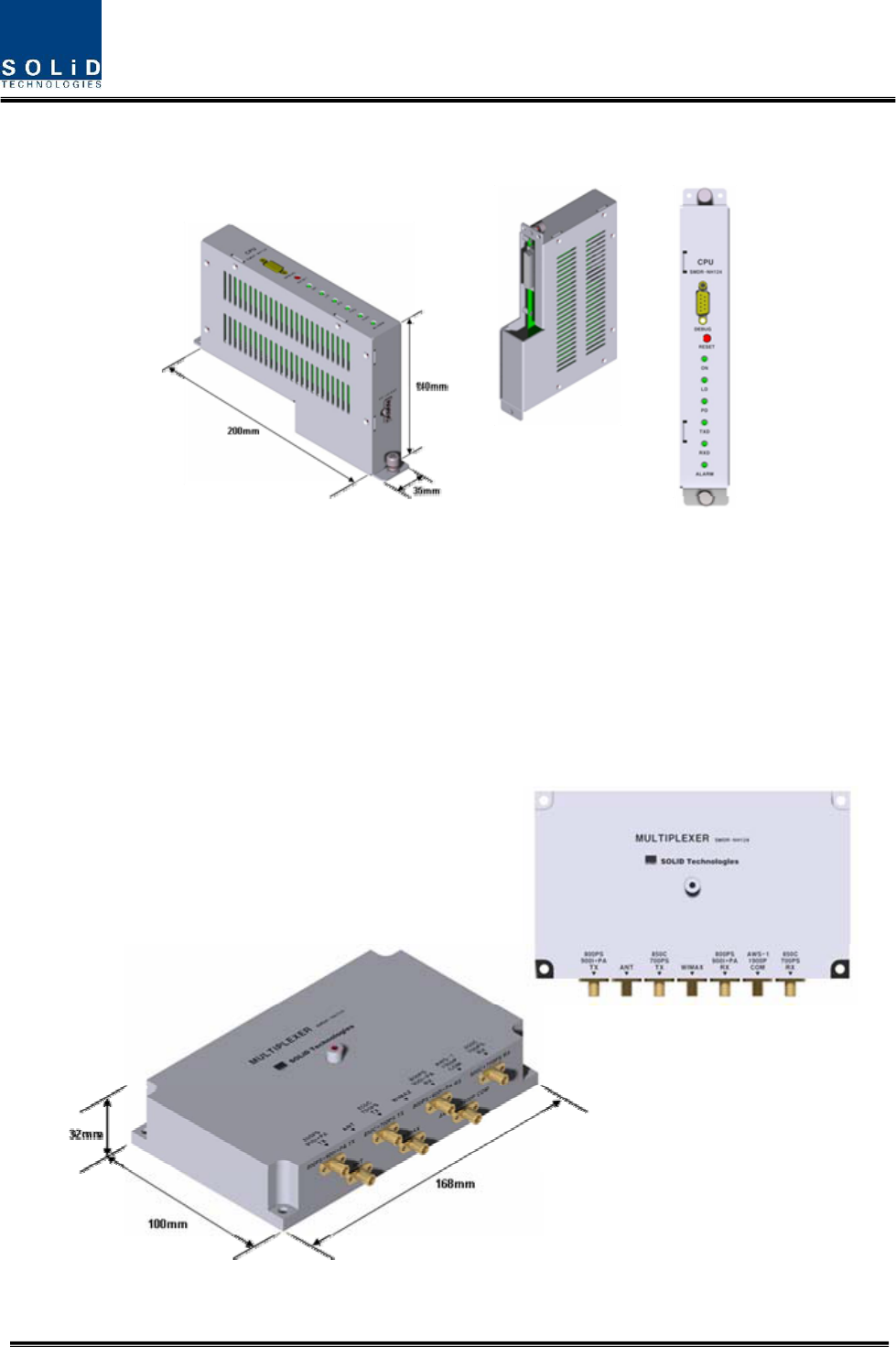
Confidential & Proprietary 47/87
check and control device status through PC and laptop. This equipment is indoor use and all the
communication wirings are limited to inside of the building.
Figure 4.29 – RCPU Outer Look
5) Multiplexer
Multiplexer works as a module to combine or distribute multiple signals into one antenna.
This device has a port to combine multiple signals. You need to connect input and output ports
of RDU through a corresponding port.
Figure 4.30 – Multiplexer Outer Look
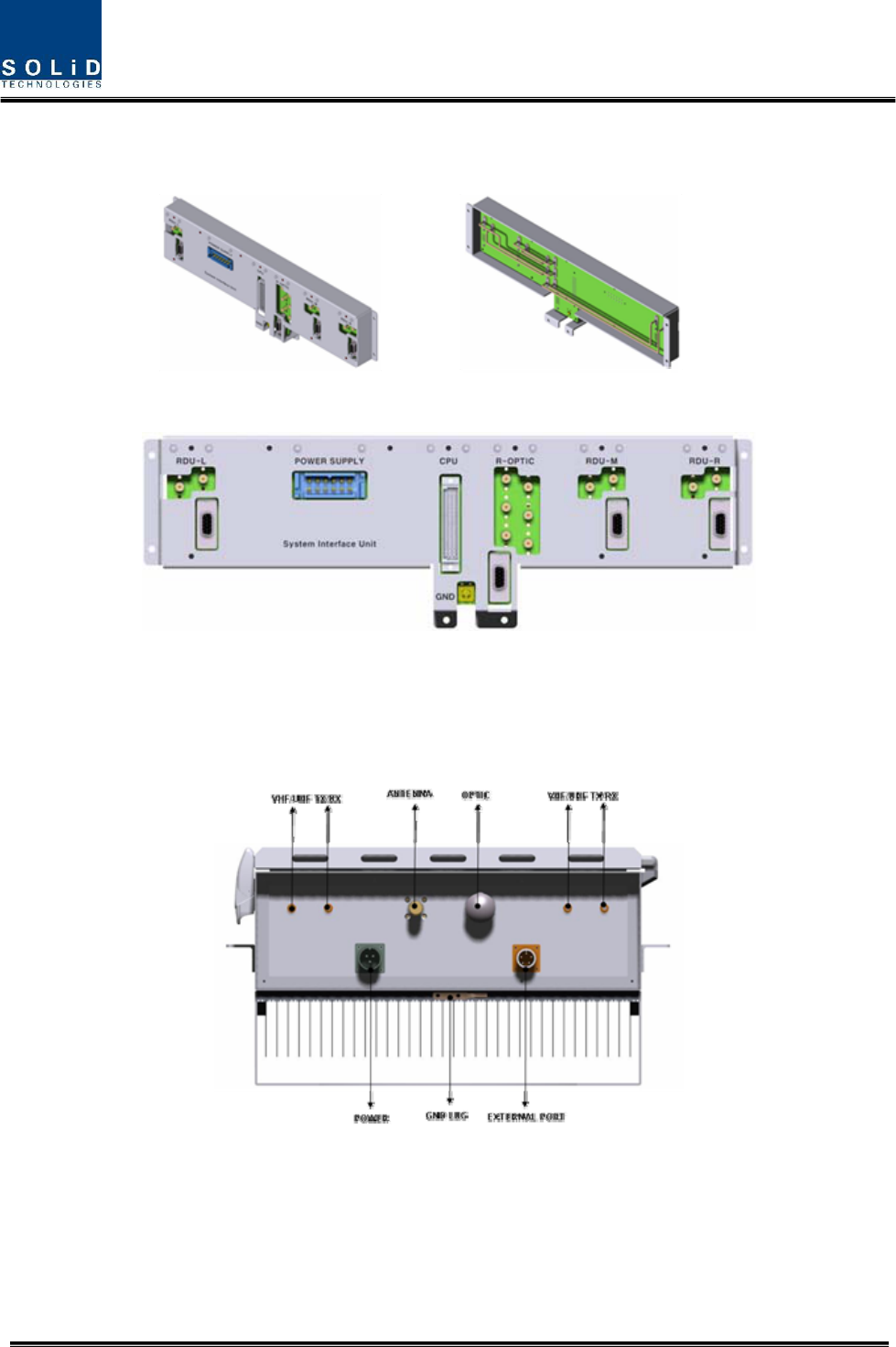
Confidential & Proprietary 48/87
6) System Interface Unit(SIU)
SIU distributes power and signals to each module.
4.4.5 Bottom of ROU
1) Functions
Figure 4.31 – ROU Bottom Look
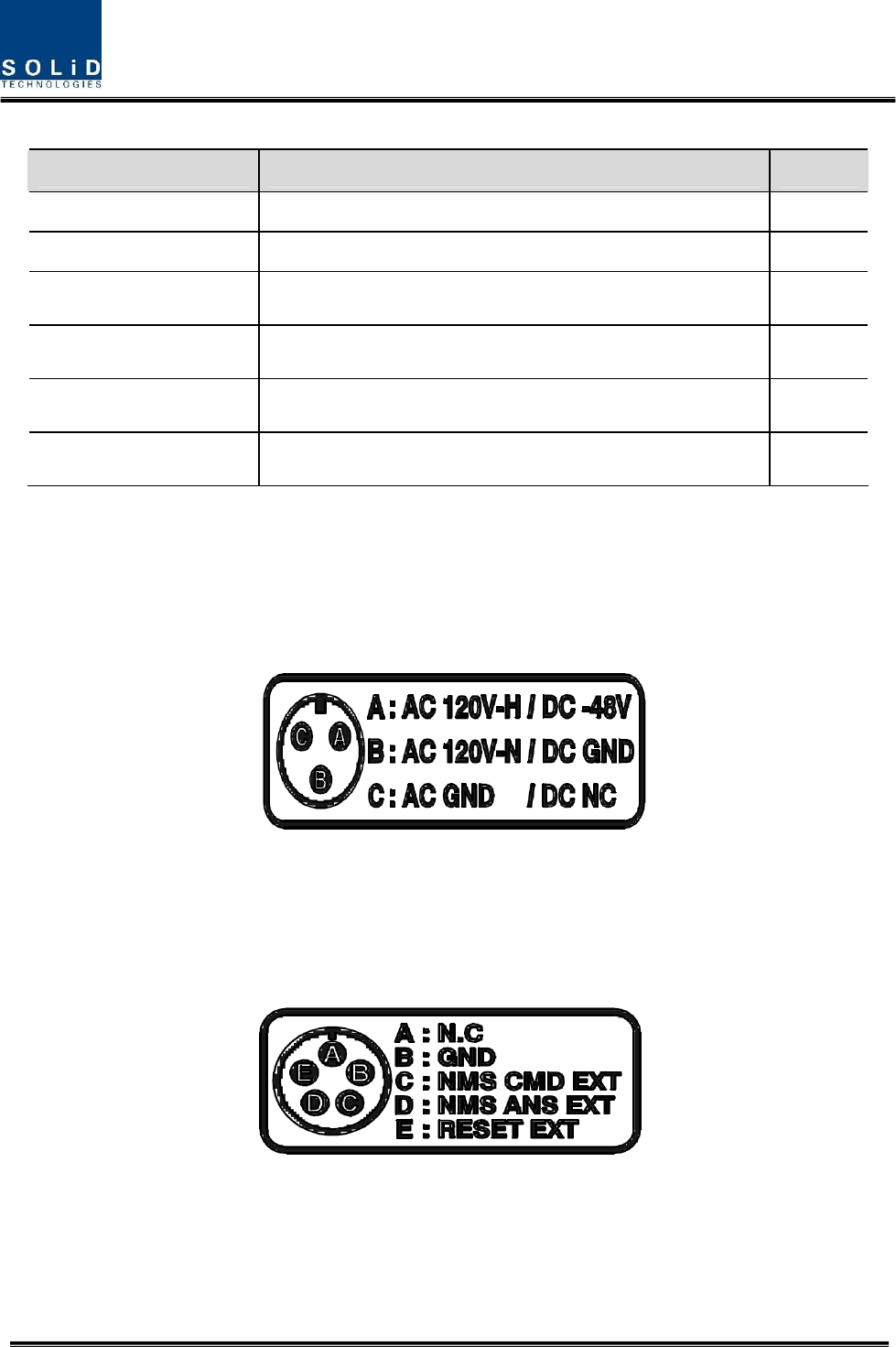
Confidential & Proprietary 49/87
Item Description Remark
1. VHF/UHF TX/RX Port Terminal for TX and RX antenna ports of VHF and UHF
2.Antenna Port System Antenna Port, N-type female
3. Power Port AC 120V input port or DC-48V input port
4. Optic Port Optical input port
5.External Port Port for external devices
6.GND LUG PORT Terminal for system ground
POWER PORT
Power ports are used for power-supplying of -48V DC or 120V AC, and specific power
cable should be applied to each different types of ROU power supply (AC/DC or
DC/DC). Below figure is naming of the power supply by type.
Exteral PORT
External ports are reserved ports for external equipments for future implementation,
and used to monitor the status and control the equipments.
Below figure is naming of the external ports.

Confidential & Proprietary 50/87
Section5
System Installation & Operation
5.1 BIU Installation
5.2 ODU Installation
5.3 ROU Installation
5.4 OEU Installation
5.5 System Operation and Alarm Status
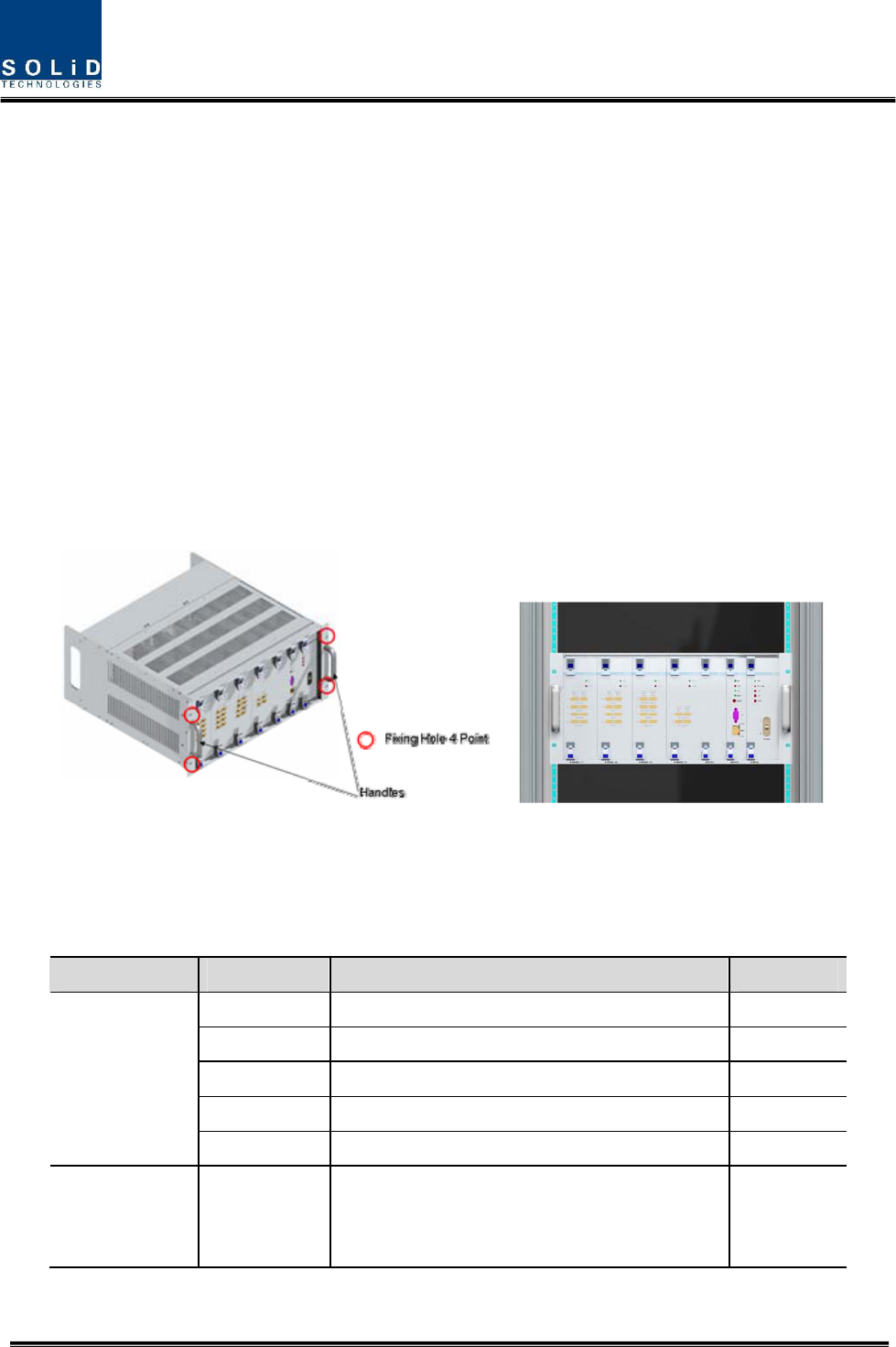
Confidential & Proprietary 51/87
This chapter describes how to install each unit and optical cables, along with power cabling
method.
In detail, the chapter describes how to install shelves or enclosuers of each unit, Power Cabling
method and Optic Cabling and RF Interface. Furthermore, by showing power consumption of
modules to be installed in each unit, it presents Power Cabling budget in a simple way. Then, it
describes the quantity of components of modules to be installed in each unit and expansion
method.
5.1 BIU Installation
5.1.1 BIU Shelf Installation
Generally, BIU is inserted into a 19” Standard Rack. As this unit has handles at each side for
easy move. With two fixing holes at each side, you can tightly fix the unit into a 19” rack.
Figure 5.1 – RACK Installation
BIU has the following components:
No. Unit Description Remark
Shelf Including Main Board, 19”,5U 1EA
MCDU - 1EA
MCPU With Ethernet Port and RS-232 Port 1EA
MPSU Operate -48Vdc Input 1EA
Common Part
Power Cable -48Vdc Input with two lug terminal 1EA
Optional Part MDBU 800PS,800PS+900I+Paging,850C,850C+700P
S, 1900P, AWS-1 MDBU
Up to 4EA
to be
inserted
Basically, the common part of BIU should have shelves and it should be equipped with MCDU
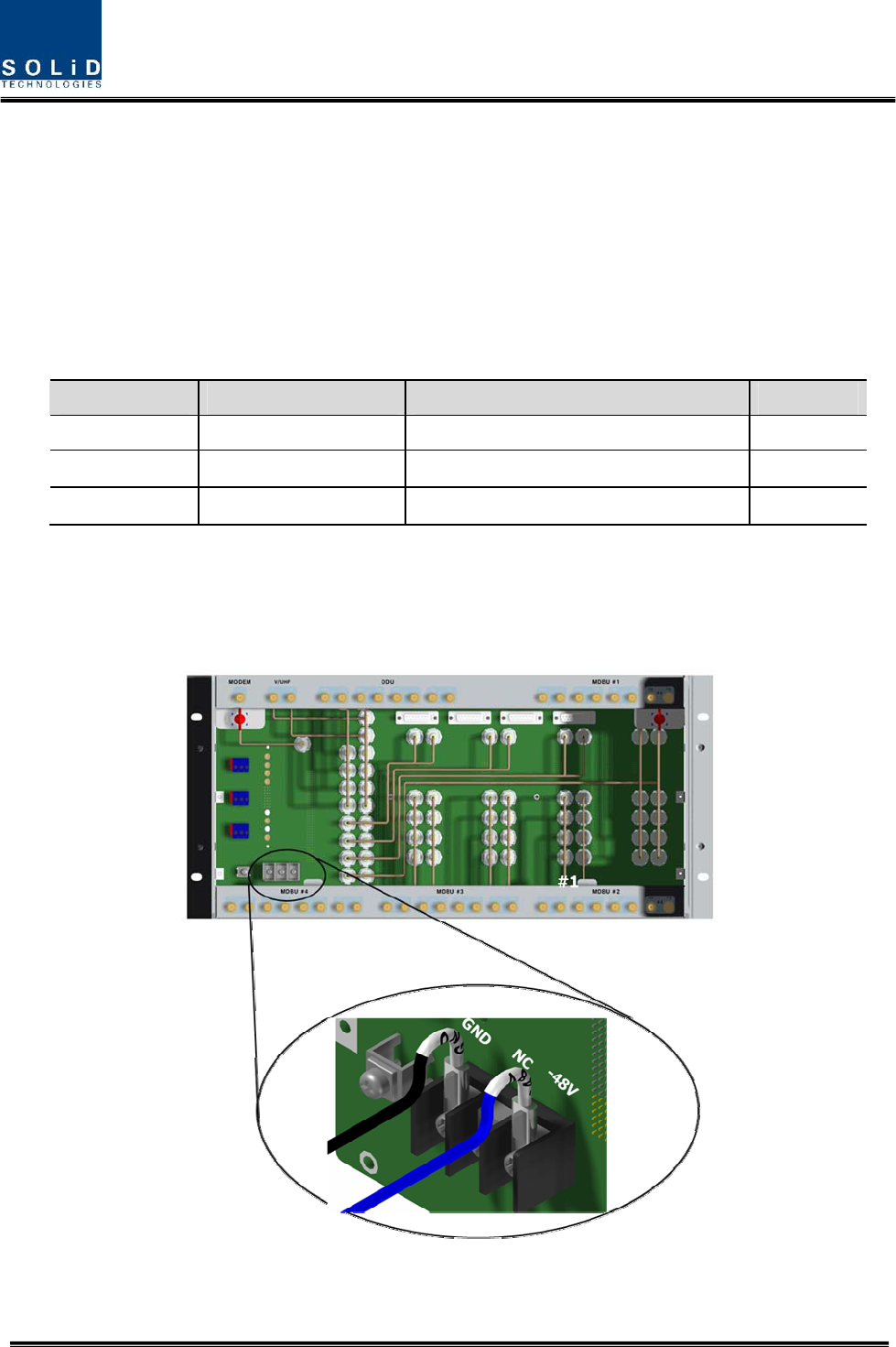
Confidential & Proprietary 52/87
to combine and divide TX/RX signals, MPSU to supply devices with power, MCPU to inquire
and control state of each module and Power Cable to supply power from external rectifiers.
In addition, MDBU can be inserted and removed to provide services for desired band (Optional).
5.1.2 BIU Power Cabling
BIU has -48V of input power. This unit should connect DC cable with the Terminal Block seen at
the rear of BIU.
Terminal Color of cable Description Remark
-48V Blue color -
GND Black color -
NC Not Connected -
Before connecting the power terminal, you need to connect "+" terminal of Multi Voltage Meter
probe with the GND terminal and then connect "–" terminal with -48V to see if “-48Vdc” voltage
is measured. After the check, you need to connect the power terminal with the terminal of the
terminal block seen below.
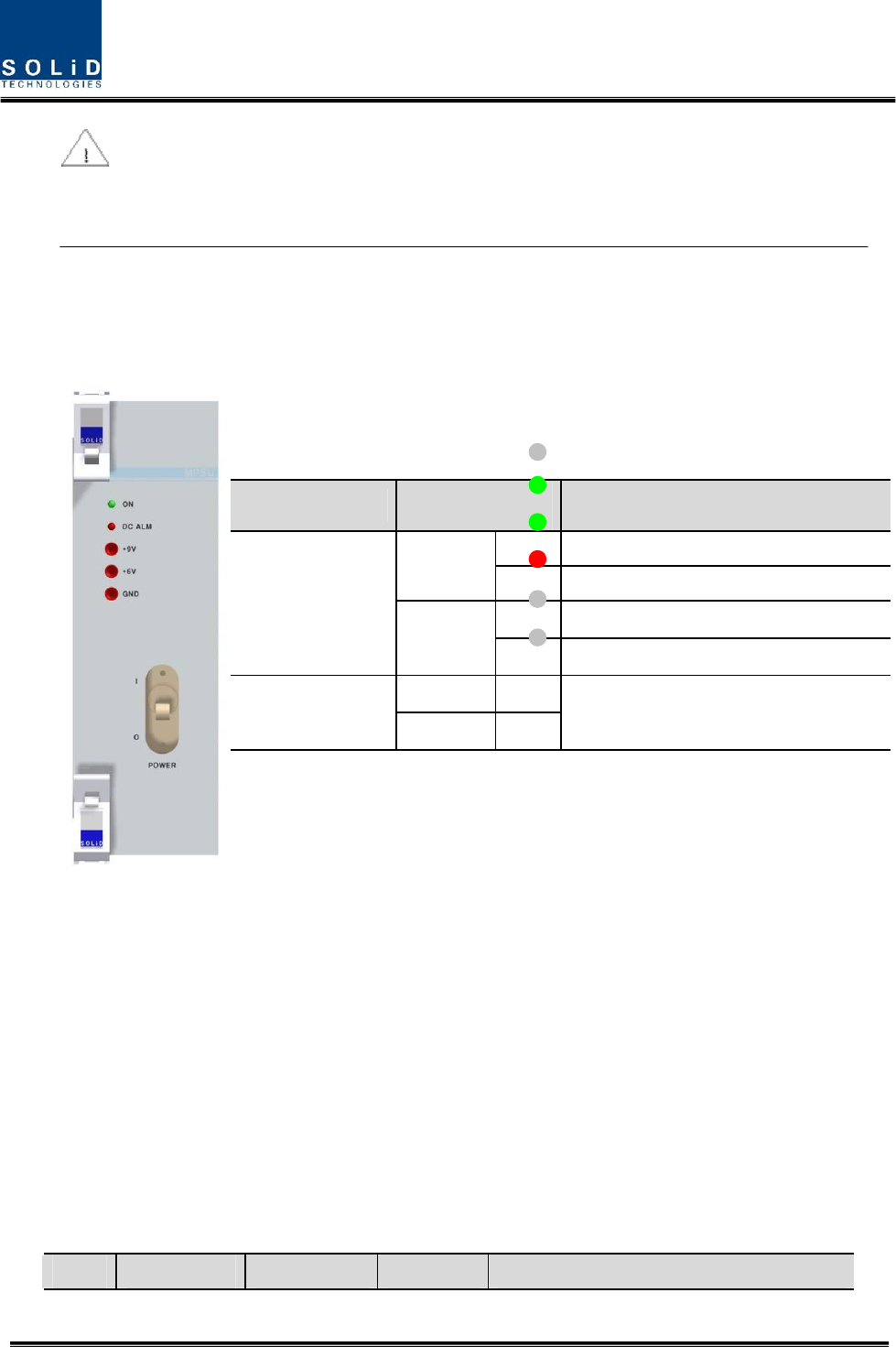
Confidential & Proprietary 53/87
Note that BIU does not operate if the "+" terminal and the "–" terminal of the -48V power
are not inserted into the accurate polarity.
When you connect -48V power with BIU, use the ON/OFF switch of MPSU located at the front
of BIU to check the power.
5.1.3 RF Interface at BIU
BIU can be connected with Bi-Directional Amplifier and Base Station Tranceiver.
To connect BIU with BDA, you need to use a duplexer or a circulator to separate TX/RX signals
from each other.
BIU can feed external TX/RX signals from the Back Plane.
Using MDBU separated from each carrier band, BIU can easily expand and interface with bands.
As seen in the table below, MDBU is divided into Single and Dual Bands. The unit can be
connected with two to four carrier signals per band. At the rear, #1~4 marks are seen in order
per MDBU. The following table shows signals to be fed to corresponding ports:
No Unit naming Description In/out RF Port
Power Switch LED Description
Abnormal, Not supply Power -48Vdc
ON
Normal supply power -48Vdc
Normal Status
O
DC ALM
Failure of output Power
ON
I
DC ALM
Normal Status

Confidential & Proprietary 54/87
TX RX
Port #1
800PS
TX(851~869MHz)
800PS
RX(806~824MHz)
1 800PS MDBU Single Band
Port#2
800PS
TX(851~869MHz)
800PS
RX(806~824MHz)
Port #3 850C TX(869~894MHz)
850C
RX(824~849MHz)
2 850C MDBU Single Band
Port#4 850C TX(869~894MHz)
850C
RX(824~849MHz)
Port#1
1900P
TX(1930~1995MHz)
1900P
RX(1850~1915MHz)
Port#2
1900P
TX(1930~1995MHz)
1900P
RX(1850~1915MHz)
Port#3
1900P
TX(1930~1995MHz)
1900P
RX(1850~1915MHz)
3 1900P MDBU Single Band
Port#4
1900P
TX(1930~1995MHz)
1900P
RX(1850~1915MHz)
Port#1
AWS-1
TX(2110~2155MHz)
AWS-1
RX(1710~1755MHz)
Port#2
AWS-1
TX(2110~2155MHz)
AWS-1
RX(1710~1755MHz)
Port#3
AWS-1
TX(2110~2155MHz)
AWS-1
RX(1710~1755MHz)
4 AWS-1 MDBU Single Band
Port#4
AWS-1
TX(2110~2155MHz)
AWS-1
RX(1710~1755MHz)
Port#1
800PS
TX(851~869MHz)
800PS
RX(806~869MHz)
Port#2
800PS
TX(851~869MHz)
800PS
RX(806~869MHz)
5
800PS+900I+PA
MDBU
Dual Band
800PS:2Port
900I:1Port
Paging:1Port
Port#3
Paging
TX(929~932MHz)
Paging
RX(896~902MHz)
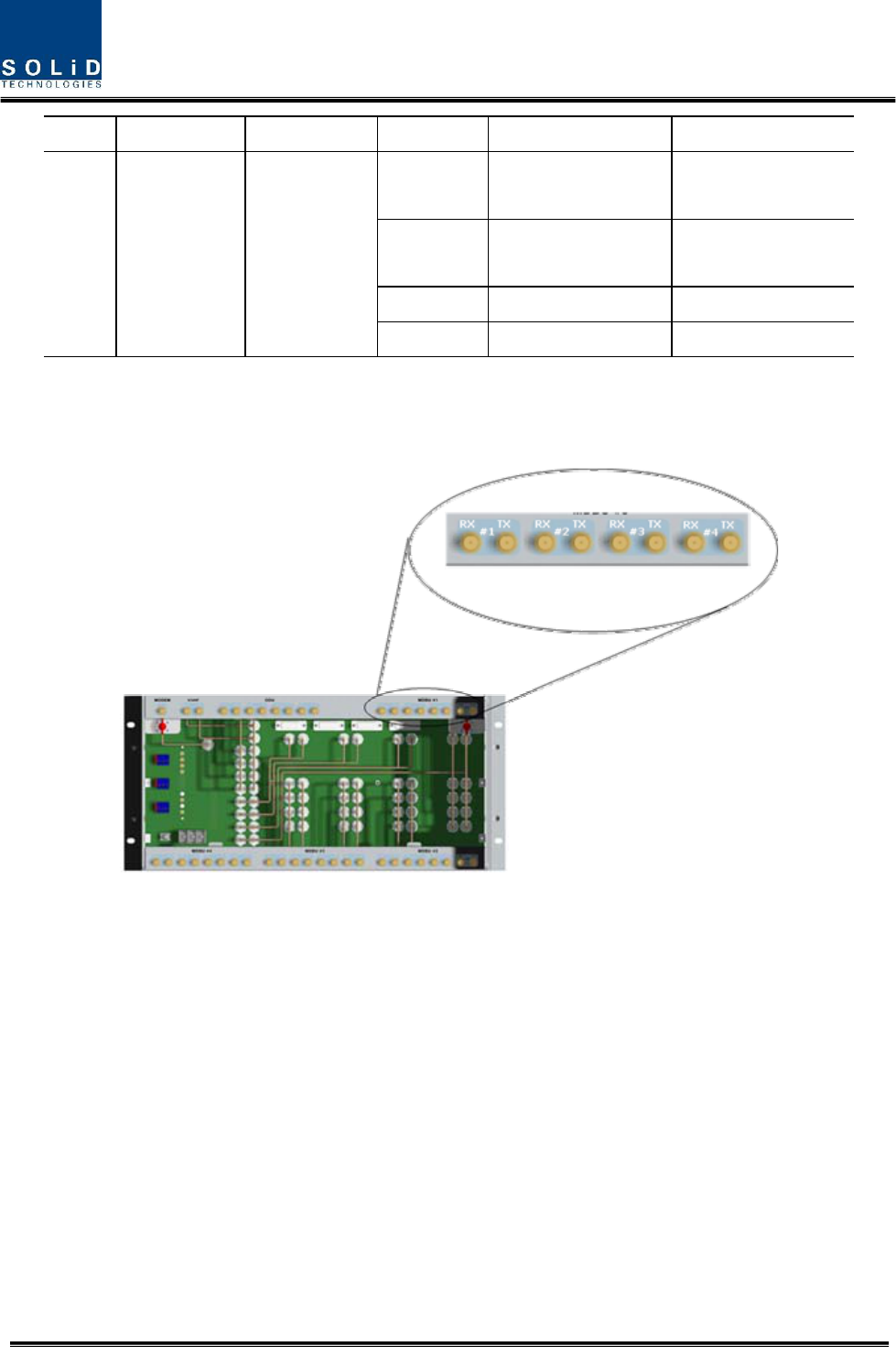
Confidential & Proprietary 55/87
Port#4 900I TX(929~941MHz) 900I RX(896~902MHz)
Port#1
700PS
TX(764~776MHz)
700PS
RX(794~806MHz)
Port#2
700PS
TX(764~776MHz)
700PS
RX(794~806MHz)
Port#3 850C TX(869~894MHz) 850C RX(824~849MHz)
6
850C+700PS
MDBU
Dual Band
700PS:2Port
850C:2Port
Port#4 850C TX(869~894MHz) 850C RX(824~849MHz)
At the rear of BIU, input and output ports are seen for each MDBU. The name of all the ports
are silk printed as "#1, #2, #3 and #4." Referring to the table above, you need to feed right
signals to input and output ports of corresponding MDBU.
For each port, TX signals and RX signals are separated from each other. You don't have to
terminate unused ports unless you want to.
BIU interface with Base station Transceiver
Basically, BIU has different TX and RX ports, and so, you have only to connect input
and output ports.
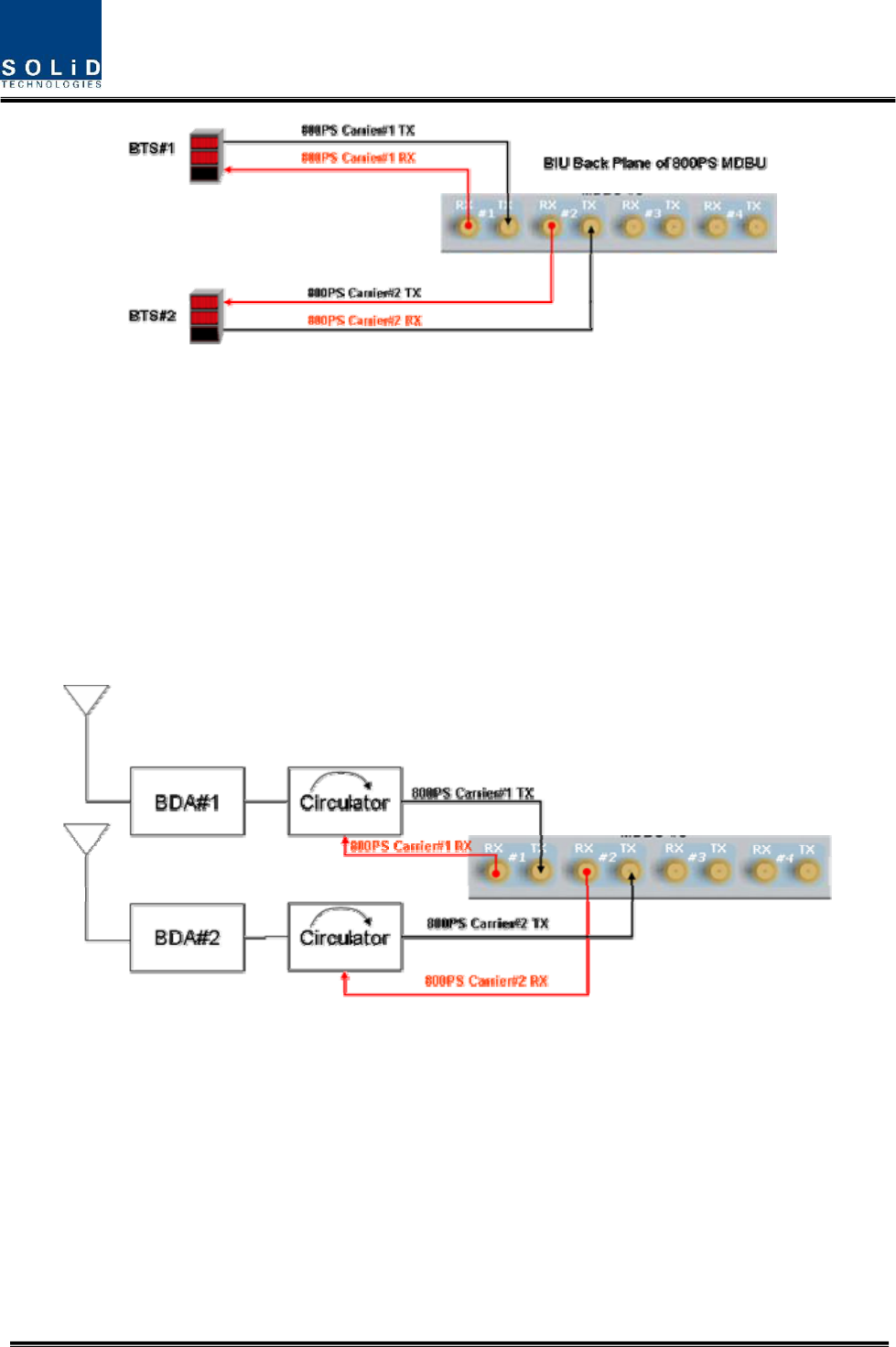
Confidential & Proprietary 56/87
Through spectrum, you need to check signals sent from BTS TX. If the signals exceed
input range (-20dBm~+10dBm), you can connect an attenuator ahead of the input port
to put the signals in the input range.
BIU interface with Bi-Directional Amplifier
Basically, BIU is in Simplexer type; when you use BDA, you need to separate BDA
signals from TX and RX type.
Using a duplexer or a circulator, you can separate TX/RX signals of an external device
from each other.
Figure 5.2 – 800PS BDA Interface using Circulator
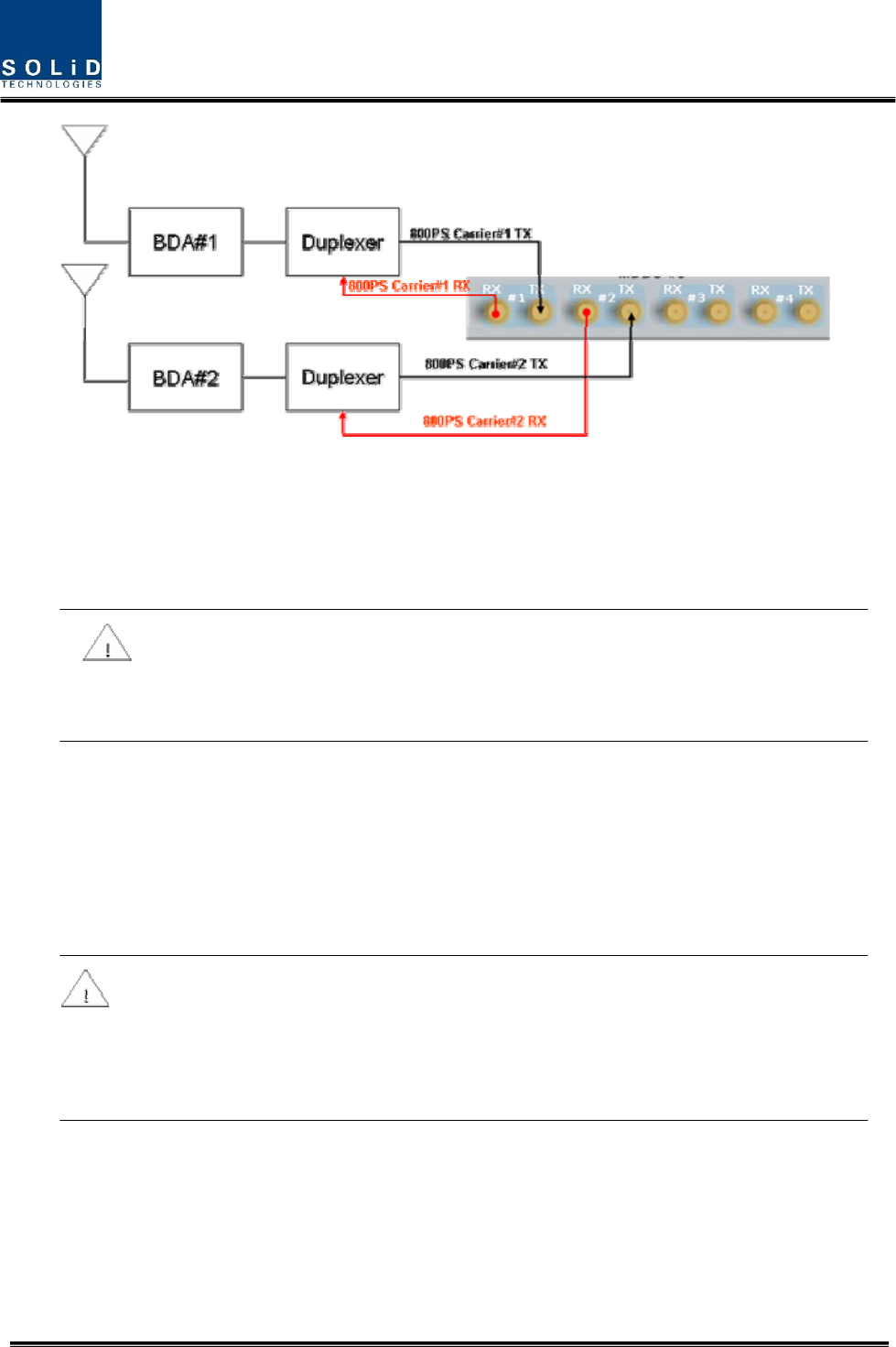
Confidential & Proprietary 57/87
Figure 5.3 – 800PS BDA Interface using Duplexer
BIU interfaces with BDA in either of the methods above. In this case, you need to
check TX input range as well.
Given the TX input range (-20dBm~+10dBm/Total per port), make sure to see if the
value is in the input range, using Spectrum Analyzer, when you connect input ports.
5.1.4 MDBU insertion
MDBU is designed to let a MDBU inserted into any slot.
BIU can be equipped with a total of four MDBUs. If only one MDBU is inserted into a
slot with the other slots reserved, you need to insert BLANK cards into the other slots.
If you do not terminate input and output ports of MCDU, which combines TX signals and
divides RX signals, it will cause loss and generation of spurious signals at the other party's band.
Given this, make sure to insert MDBU BLANK into slots of MDBU.
When MDBU is inserted into BIU, LED at the front panel will show the following information:
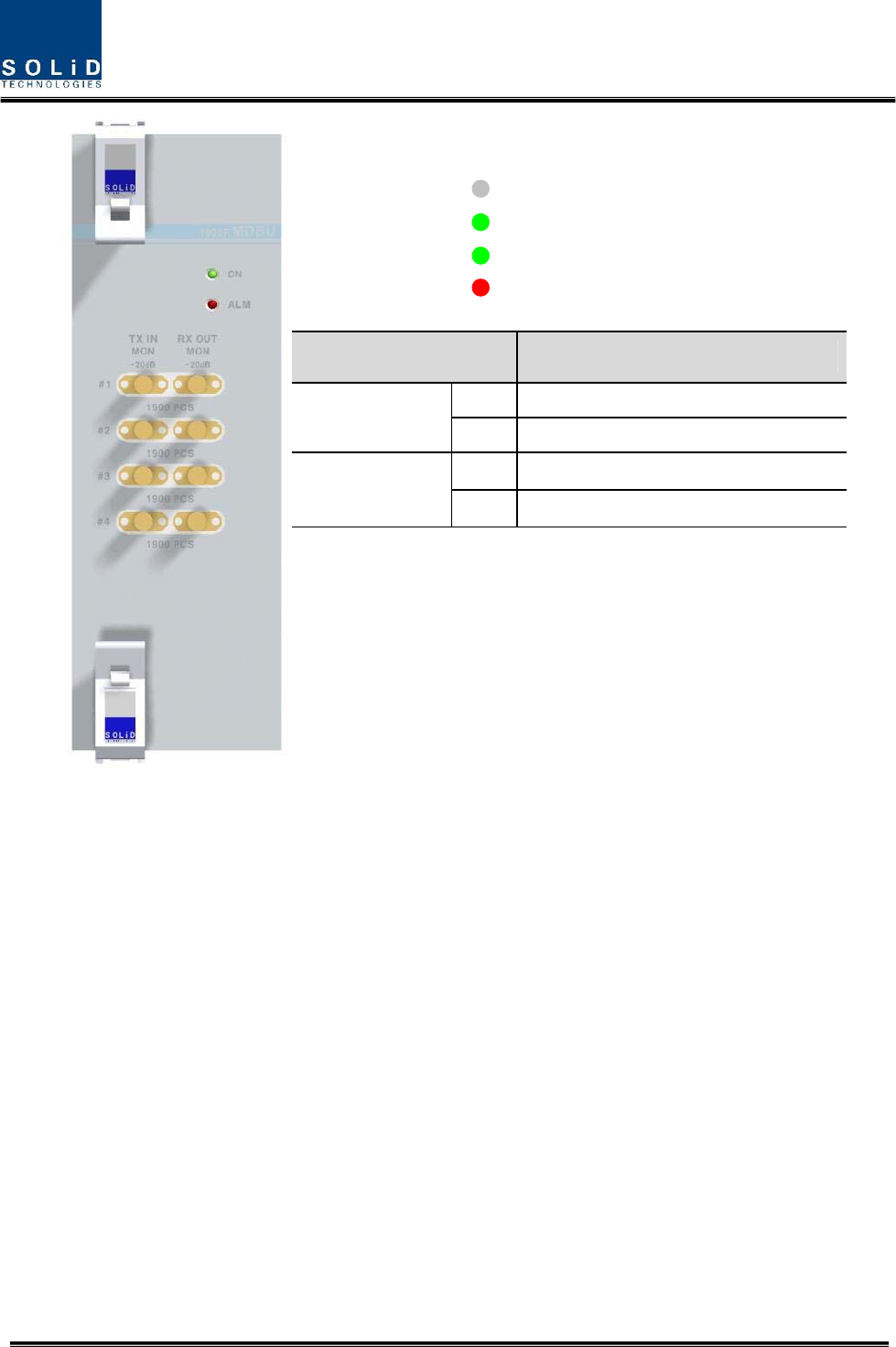
Confidential & Proprietary 58/87
MONITOR SMA port seen at the front panel of MDBU enables you to check current
level of TX input and RX output signals in current service without affecting main signals.
TX MON is -20dB compared with TX Input power and RX MON is -20dB as well
compared with RX Output power.
5.1.5 ODU Interface
BIU supports up to four ODUs. At the rear of BIU, eight RF input and output ports for
ODU and four power ports for power supply and communication are provided. At BIU,
you can check installation information of ODU.
LED Description
Power is not supplied.
ON
Power is supplied.
Normal Operation
ALM
Abnormal Operation
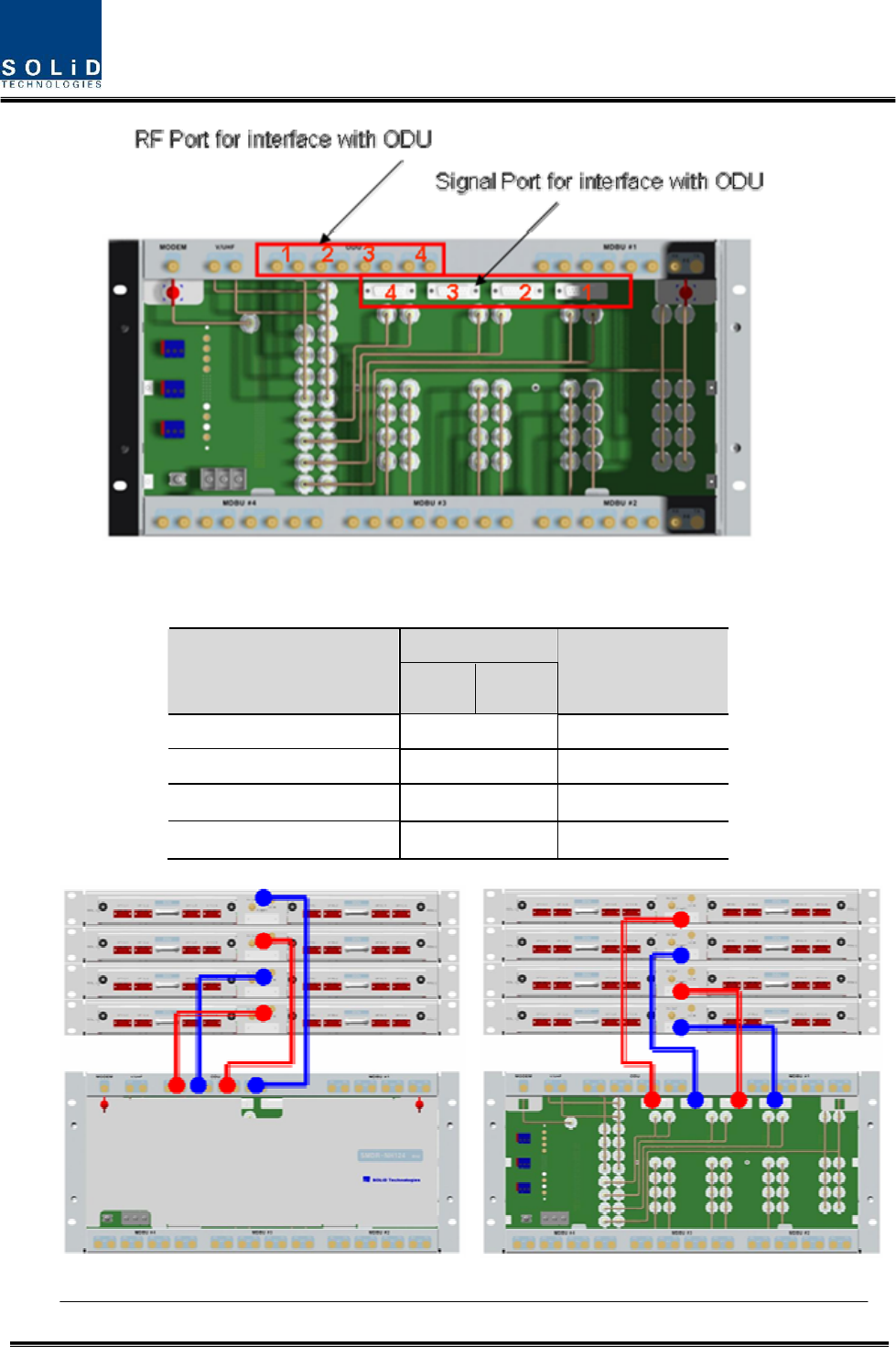
Confidential & Proprietary 59/87
At the rear part of ODU, the number of RF Ports and Signal Ports are printed in order.
Therefore, you need to be careful in case of expansion of ODU.
RF Port
ODU Numbering TX RX Signal Port
ODU 1 #1 ODU-1
ODU 2 #2 ODU-2
ODU 3 #3 ODU-3
ODU 4 #4 ODU-4

Confidential & Proprietary 60/87
If ODU is not connected in the right order, related devices may fail to communicate with
each other or the unit may read wrong information. Given this, you need to connect the unit with
accurate RF Port and Signal Port in a corresponding number.
For unused RF Ports for ODU expansion, make sure to terminate them using SMA Term.
When you put ODU on the top of BIU, it is recommended to install the unit at least 1U
apart from BIU. Heat from BIU climbes up to reach ODU.
5.1.6 Consumption Power of BIU
The table below shows power consumption of BIU:
Part Unit Consumption Power Remark
Shelf
MCDU
MCPU
Common Part
MPSU
7.5 W
MDBU 800PS 12W
MDBU 800PS+900I+Paging 20W
MDBU 850C 12W
MDBU 850C+700PS 19W
MDBU 1900P 20W
MDBU
MDBU AWS-1 12W
BIU supplies power for ODU. Therefore, when you want to calculate total power consumption of
BIU, you need to add power consumption of ODU to the total value.
Power consumption of ODU is given in the later paragraph describing ODU.